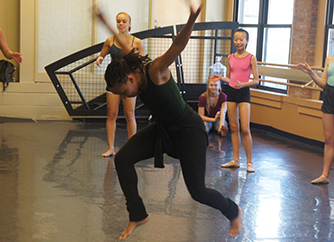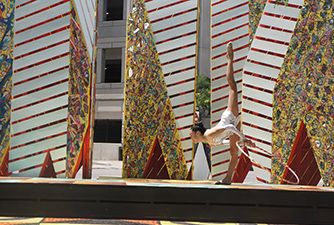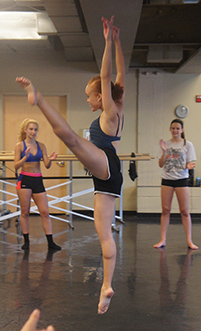Dance is Alive and Well and Living in Detroit

Four dancers from Epiphany Dance perform in Harmonie Park during DDCF.
“If you’re going to do a triple, it’s got to be fast.” The spacious stage of the Detroit Music Hall stage looked skeletal as thirteen young women learned a complex piece of jazz choreography. Well, thirteen young women and one virtuosic young man, no more than eleven years old, whose pirouettes were right on par with the rest of the class. The sounds of Cher and Chaka Khan echoed off of the art deco ceiling of the theater before sinking into the rich red velvet of the seats. Dancers pulsated with energy, hitting each beat meticulously for just a moment before leaping into the next one.
My weekend at Detroit Dance City Festival was full of moments like that. The Festival, in its third year during Summer 2015, is the brainchild of ARTLAB J founder and dance innovator Joori Jung. Originally from Seoul, Korea, she moved to Detroit and, in two short years, took it upon herself to make Detroit more open to the international dance community. The weekend of the Detroit Dance City Festival was a conglomerate of art makers, performers, and the business-minded people making dance a sustainable practice. Some attendees did all three.
Mind you, I was very much a fly on the wall here. I Irish-danced as a girl, but I had hung up the hard shoes a while ago and was perfectly content with observing this perfectly postured world as it spun around me. Workshops like the one in the Music Hall were happening every day and ranged in focus from jazz to modern to West African. I watched many of them, but my personal favorite was taught by Beatrice Capote, a dancer in Camille A. Brown and Dancers company. Once the class began, the West African drum beat hardly ever stopped. Beatrice built small gesture upon gesture, introducing this unique style of dance to a large group of students foreign to the form, until the room was full of stomping feet and flailing arms, all somehow keeping time to the impossibly quick rhythm. One of the most important elements of this style, Beatrice stressed, was connection. West African dance is a form of communication, a way to celebrate the extraordinary elements of the ordinary day. Certainly this was true of the workshop. What began as a group of serious, focused young artists melted into a crowd of smiling young people, improvising, applauding, and laughing.

Beatrice Capote leads an improv session during her workshop.
That evening, Beatrice would perform a portion of Black Girl — A Linguistic Play with her fellow company members from Camille A. Brown and Dancers at the DDCF Gala, the cornerstone of the weekend. To begin the conversation on some of the elements of this work, she asked her workshop participants what they thought about when they heard the words “black girl.” There was an awkward silence, and I admit I was glad I didn’t have to come up with a response; there is no right answer to that question, but there are definitely wrong ones, and everyone treaded carefully with choice of words. Beatrice had obviously asked this question before and was familiar with this reaction. In fact, she said that it was this tension surrounding the concept of “black girl” identity that prompted Camille A. Brown and her dancers to create this work. Using what Beatrice referred to as “vernacular dance,” the company has referenced playground interactions, sibling bickering, handshakes, and pop culture (if you look closely you can spot Beyoncé’s infamous Single Ladies chug) to elevate the experience of young black women. The performance was moving, and the piece in its final state, coming to UMS in February, will not be one to miss.
The weekend was full of performances. I spent my late afternoons in the charming Harmonie Park across from the bustling Carr Center watching local dance troupes perform in beautiful sunshine. One group of four young girls from Epiphany Dance, a Detroit-based company, stood out in particular. Clad in bright yellows and greens, they glided across the stage in beautifully executed choreography. As I watched I couldn’t help but connect their passion with what is at the heart of Camille A. Brown’s work; these girls, sharing what they love without reserve or restraint, seemed to me to encompass what Camille might seek to capture in her art. Many of these outdoor performances felt just as joyful. I loved the way the brief season of Michigan warmth was animated through hip-hop, lyrical, rhythmic gymnastics, even Polynesian dance.

An exciting rhythmic gymnastic performance in Harmonie Park.
In the evenings, the art makers shined at the Choreographer Showcases. The first two nights of the Festival featured over twenty pieces from choreographers from across the country. I, like many, am a bit of a novice to the current trends in dance, and was pleasantly surprised to discover that dance is capable of much more than I initially assumed. I learned that, contrary to popular belief, dance does not need music. I saw multiple pieces in partial or total silence, pieces that kept me completely engaged. Dance can also use video, voice, and live music to elevate movement. One of my favorites used traditional mime techniques melded to modern hip hop to create a metaphor for immigrating to the states. I was mesmerized. As one participant told me, “The modern movement blew open the possibilities of dance, and we’ve been trying to figure out to do with it ever since.”
While performance was certainly the focus of the Festival, the weekend had an undercurrent of stimulating conversations about sustaining dance in Detroit and strengthening the international dance community. Through a series of panel discussions, I learned about the numerous organizations in Southeast Michigan who are dedicated to helping dance and those who create it thrive. Shivangee Pandya represented Creative Many, a group that advocates for the development of professional artists in Michigan. They provide legal aid, educate on the fundamentals of becoming a non-profit, and assist in contract work. They recognize that being a professional artist means running a business, and their dedication to the establishment of solid foundations for these artists shows a profound respect the dignity of creative work. I had the chance to chat with Lynne Friman of Culturesource and IXITI, a website that posts any and all creative performances and events happening in and around Detroit. With a shock of purple and blue hair and a big smile, she was able to list at least three people in the Detroit arts scene that you must know, all within the first five minutes of my chatting with her. She, and many others in attendance, are living advocates for the growing number of dance, theater, and music artists in the area, and they’re dying to tell you about it.

A dancer leaps during Beatrice’s workshop.
Equal parts celebration and exploration, the Detroit Dance City Festival never shied away from asking what dance is capable of. It wondered if it needed music, how it could be filmed, what props it could use, and who had access to it. The result was a real sense of community, a group of people who are willing to decide where dance can go from here. They will create the work, fund it, and find the audience, and they’ll enjoy the process just as much as the final product. It was exciting to be in on the secret that Detroit is rising fast on the global dance scale. Something tells me it won’t stay a secret for long.


